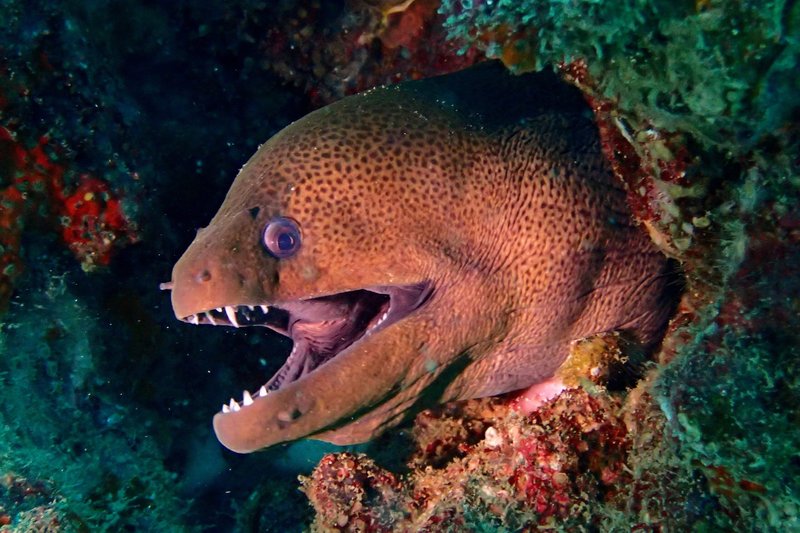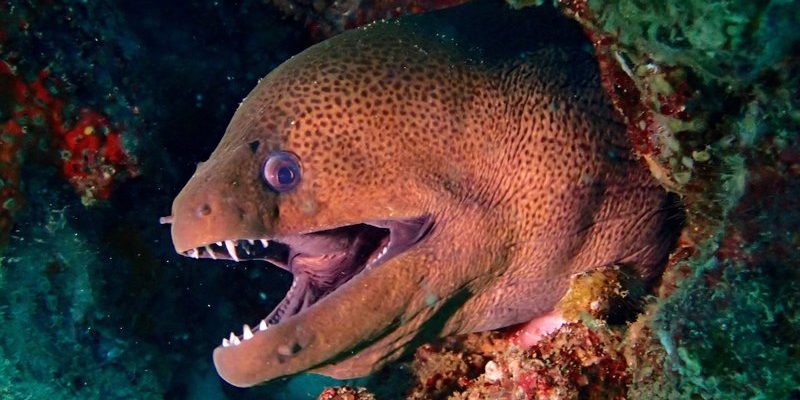
Moray eels, with their elongated bodies and striking patterns, are not just eyecatchers; they’re skilled hunters. Honestly, understanding what they eat and how they go about catching their meals reveals a lot about their behavior and role in the marine ecosystem. Whether you’re an aquarium enthusiast or simply curious about ocean life, uncovering the diet and feeding habits of these eels is like peeling back the layers of an onion—there’s so much depth to discover!
What Do Moray Eels Eat?
Let’s start with the basics. Moray eels are carnivorous, meaning they primarily eat meat. But what exactly does that entail? Their diet mainly consists of:
- Fish: Smaller fish are often on the menu. Moray eels are skilled at sneaking up on their prey. With their excellent sense of smell, they don’t let a meal slip away easily.
- Crustaceans: These eels love to munch on crabs and shrimp. Think of it like a gourmet dinner for them, with crustaceans being the main course.
- Octopus and Squid: Larger moray eels sometimes target octopus or squid, turning their meals into an exciting underwater challenge.
You might be wondering, “How do they catch these fast-moving meals?” That brings us to their hunting techniques, which are quite fascinating.
Hunting Techniques of Moray Eels
Moray eels have some unique strategies for catching their food. Unlike many fish that swim swiftly, moray eels rely on stealth and surprise. Here’s how they get the job done:
1. Camouflage: Moray eels often blend in with their surroundings. Their colors and patterns help them hide in the rocks and corals. This means their prey can’t see them coming, giving the eel a significant advantage.
2. Ambush: Once they spot a meal, moray eels can launch a quick strike. They’ll lunge out from their hiding spots, catching fish and crustaceans off guard. Imagine the thrill of a ninja in the water!
3. Strong Jaws and Teeth: Moray eels possess sharp, pointed teeth that help them grip slippery prey. They can’t exactly bite through shells, but they can grab and hold onto their food while making the final kill.
These techniques make the moray eel a remarkable predator in its habitat. It’s a game of patience and precision, and they excel at it!
Feeding Habits and Patterns
When it comes to feeding habits, moray eels have their own unique routines. They tend to be most active during the evening and night, making them nocturnal hunters. Here’s why this matters:
– Nighttime Advantage: By being active at night, they can hunt more effectively. Many smaller fish and crustaceans are also more active during dark hours, making it a win-win situation.
– Territory and Competition: Moray eels often stake out specific areas where they hunt. They may compete with other predators, like groupers, but their stealthy approach gives them an edge.
– Feeding Frequency: These eels don’t eat every day. Instead, they eat larger meals when they can catch something substantial. This means they’re not lunching every hour but rather making the most of every successful hunt.
Such feeding patterns have allowed moray eels to thrive in their environments. Understanding these habits helps us appreciate how nature balances these ecosystems.
Moray Eels and Their Role in the Ecosystem
You might be surprised to learn that moray eels play a crucial role in maintaining healthy coral reef ecosystems. Here’s how they contribute to the balance:
– Population Control: By feeding on smaller fish and crustaceans, moray eels help keep those populations in check. This prevents any one species from becoming too dominant, which can harm the overall health of the reef.
– Prey for Larger Predators: On the flip side, moray eels themselves are prey for larger fish and sharks. They’re part of a larger food web, supporting the diets of other marine creatures.
– Habitat Maintenance: As they hunt among the reefs, moray eels also help maintain the structures by keeping it clear of excess population. This means their presence is vital for the overall health of their habitats.
Understanding these roles helps us appreciate the interconnectedness of all ocean life and how every creature, big or small, plays a part in the ecosystem.
Common Misconceptions About Moray Eel Diet
Sometimes, people have the wrong idea about what moray eels eat and how they behave. Let’s clarify some of those misconceptions:
– Moray Eels Are Not Aggressive: While they might look fierce with their sharp teeth and menacing appearance, moray eels are not typically aggressive toward humans. Most of their hunting is focused on smaller fish and crustaceans. They’re more interested in avoiding confrontation than picking a fight.
– They Don’t Just Eat Fish: While fish make up a significant part of their diet, moray eels are quite opportunistic. They’ll eat whatever is available, including squid and crustaceans. Their menu can vary based on what’s abundant in their local environment.
– Moray Eels Don’t Only Hunt Alone: Though they are solitary hunters, moray eels have been observed hunting in pairs. This teamwork can sometimes lead to more effective hunting, especially when targeting larger prey.
Debunking these myths helps us understand and appreciate these creatures better, shedding light on their true nature.
In summary, the diet and feeding habits of the moray eel showcase their fascinating role in ocean ecosystems. From their hunting techniques to their contributions to the marine food web, these eels are more than just slinky predators lurking in the shadows. They’re vital members of their environments, balancing the populations of various species and supporting the health of coral reefs.
So, the next time you hear about moray eels, remember: they’re not just fearsome creatures; they’re also skilled hunters with intriguing habits. Understanding their diet enriches our knowledge of marine life and reminds us of the complexity of the underwater world. Isn’t it amazing how every creature, no matter how slippery, has its place in the grand scheme of nature?

